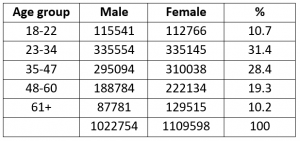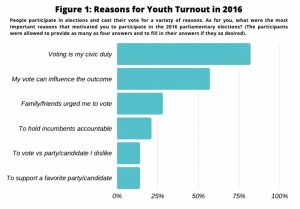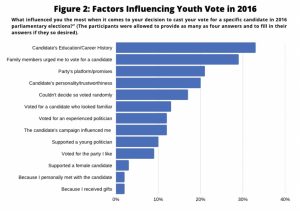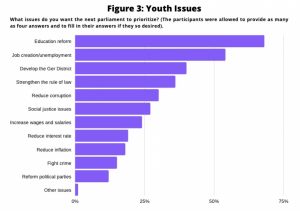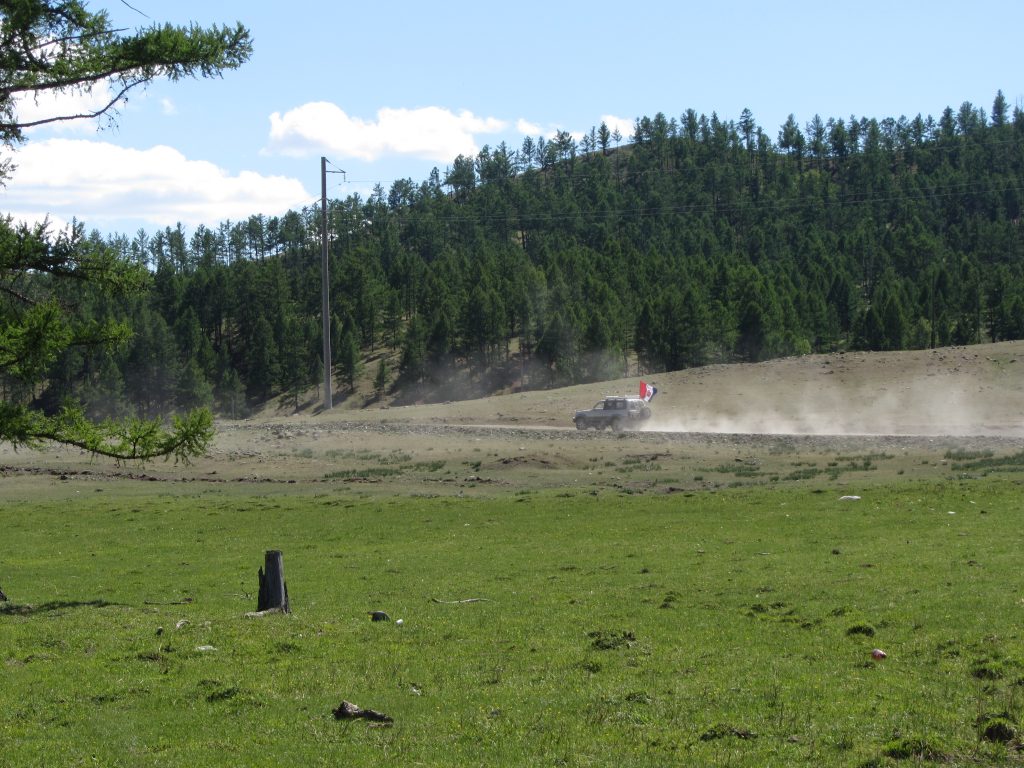By Byambajav Dalaibuyan and Mendee Jargalsaikhan
Education is one of high priority issues in political party campaign platforms. We choose three campaign platforms, – the Mongolian People’s Party, the Democratic Party, and the Right Person Electorate, a coalition of the National Labor Party (HUN), Mongolian Social Democratic Party, and Zui Yos Party. All three addressed challenges for pre-schooling, the secondary school system and vocational and higher education.
Instead of comparing every aspects of their educational policies, we compared how they addressed four main challenges that have been emphasized in research reports and policy discussions in the last several years: (1) the inequality of access to quality education, (2) skills and values, (3) inclusion and rights of children, and (4) teacher development and school management. Furthermore, because all parties promise to improve the quality and access of vocational and high education, we compared their policy priorities in this regard.
The inequality of access to quality education
The segregation of schools along the lines of the public vs. private and urban vs. rural is a vivid expression of social inequality in Mongolia. On the one hand, Mongolia already has several layers of expensive private schools and public model schools and on the other hand, overcrowded and under-funded public schools. Children in the second group have less opportunities to get education that can help them pursue their educational and occupational dreams. In recent years, for example, Ikon.mn has presented data analyses of widening gaps in school education, including exam scores between the first and second groups of schools, and facilitated a lot of discussion on this important issue.
MPP’s platform gave more emphasis on infrastructure development. The party promises to build 273 new kindergartens and 200 schools and make the transition from double shifts to one shift at 80% of all schools. These are very optimistic numbers if we look at the development of the number of kindergartens and schools in the past 5 years.
Number of kindergartens and schools
| 2015 | 2016 | 2017 | 2018 | 2019 | |
| Kindergarten | 1288 | 1354 | 1416 | 1435 | 1439 |
| Schools | 768 | 778 | 798 | 803 | 820 |
Source: 1212.mn
The MPP wants to establish “model schools that have international standards and meet quality requirements” in every aimag and Ulaanbaatar districts. In 2010, the MPP-led cabinet initiated a program on integrating Cambridge standards into secondary school curriculum and established the first “model schools with Cambridge curriculum” in Ulaanbaatar. So, it seems that MPP wants to scale-up this program. But will these “models” or another layer of schools help Mongolia’s children get equal access to good education?
The DP noted serious achievement discrepancies between urban and rural schools as well as private and public schools. The party proposes a “national program on eliminating gaps in education quality.” The platform does not provide any details about the program and its specific targets.
The DP sets a target that the maximum number of children in one classroom should not exceed more than 30. Again, no details are provided when and how this should be achieved. Surely, this allows DP candidates to make promises on building new schools and kindergartens in their electoral districts to compete with many MPP candidates, who had “built” new ones and promised more.
The platform of the “Right Person-Electorate” includes a number of ways to address the inequality of access to quality education: (1) transition to one shifts at all schools, (2) improvement of the learning environment and resources, (3) targeted teacher development policies, and (4)student-centred flexibility in high schools (subject selection and apprenticeship options).
Skills and values
Do the campaign platforms propose any changes in curriculum content? If so, what values and skills do they emphasize?
All platforms highlight the importance of Mongolian culture, history, tradition, heritage, lifestyle, and language in the national curriculum. However, we can see some interesting differences.
The MPP promises to integrate more content on national history, culture, patriotic thinking, and respect for national values into the national curriculum and implement it at all schools. In fact, the platform does not highlight any other skills and values.
The DP promises to re-introduce the “Right Mongol Child” program that the DP-led government implemented in 2012-2016. The program focused on instilling creative and independent thinking skills and national pride of history, culture and tradition. In addition, DP proposes to make English a compulsory second language. The party also emphasized the importance of digital literacy and promised to integrate it into the national curriculum.
“The Right Person-Electorate” presents very detailed steps for curriculum reform, including the introduction of student-centred assessment methods, digital skills and life skills. However, they emphasize the importance of stability of the national curriculum. They propose a mandatory practicum of all school children at herder families to learn Mongolian culture and nomadic way of living. Of course, the full implementation of this idea will not be easy but it seems to exemplify their emphasis more on culture, values and ethics rather than patriotism and pride.
The inclusion and rights of children
All three parties include goals on improving online and distance education. The importance of online and distance learning has became clear as the pandemic outbreak forced all educational institutions to find ways to continue schooling. Negative impacts of the current COVID pandemic on children’s educational achievement have been more acute for disadvantaged and poor families. All campaign platforms include a number of policy options on enhancing the rights of children to education and healthy and safe environment. This ranges from improving toilets to building sporting/cultural facilities and, to accommodating special needed students.
Policies on children’s rights and safety
| MPP | DP | Right Person-Electorate |
| To enable children with physical and special needs to study at regular schools | To implement a program on supporting professionals who work with children with special needs | To support program on full school enrolment of children with disabilities |
| To replace pit toilets at all schools and kindergartens by modern toilets | To require all school buildings to have special stairs and rumps | To implement programs on prevention of bullying |
| To develop home schooling programs for 6-8 years old children of herder families | To implement independent auditing of the land use of schools and to advocate child-friendly environment |
Teacher support and development
All three parties promise to increase teacher salaries. Teachers’ unions organized nation-wide strikes and demonstrations in 2018 to demand salary increases. In the 2020 budget, the MPP increased teacher salaries by 8% (from about MNT760,000 to MNT840,00). The party promised to increase salaries further in its platform but in line with inflation rates. The DP and “Right Person-Electorate” promises to increase teacher salaries to the level of the national average salary (currently MNT953,000).
All three parties emphasize the importance of teacher development in education. The MPP proposes to implement a “Skillful Teacher Program” that focuses on continuous skill development through domestic and international training programs. The DP will implement a “New Teacher Program” and focus on improving teacher training institutes and allocating more budget for teacher re-training and development programs. The “Right Person-Electorate” will implement a “1000 Teacher Program” for teacher training and international exchange, encourage students to study at teacher training universities through scholarship programs, and support teachers in remote regions.
School management
One of the major challenges for all educational institutions has been the increased politicization of secondary schools and kindergartens following the changes in the political landscape (e.g., post election, change in the parliament and cabinet, and even after political changes in the aimag and soum governance). Political parties or influential politicians use the leadership posts of secondary and kindergarten to reward party supporters or members or those with a personal connection. This undermines the merit-based principle for school management and faculty development at these schools. Thus it impacts the quality of the education. The MPP promises to keep schools from political influences and enforce merit-based appointment policies for school presidents and principals. The DP proposes to establish “Educational Councils” of citizen representatives that will have a role in appointing and dismissing school principals. The “Right Person Electorate” promises to improve coordination between education authorities and institutions at national, regional and local levels.
Vocational and high education
All three platforms include promises on improving access to education loans. Similarly, they include promises on scholarships: scholarships for best students (MPP), scholarships for 10,000 students to study abroad (DP), and income and achievement based scholarships (Right Person Electorate). Notably, only the “Right Person Electorate” platform includes goals on improving transparency and accountability of government programs on education loans and scholarships.
Vocational and high education goals in campaign platforms
| MPP | DP | Right Person-Electorate |
| To establish university complexes as science and Innovation centres | To increase university-based research institutes and laboratories and establish international science park | To improve the governance of state universities and competition and cooperation among them |
| To increase the research and development budget of science and innovation institutes 4 times | To scale-up “1000 Engineer Program” to “10,000 Engineer Program” | To enable getting university degree in three years |
| To establish branch universities in regional areas specialising in agriculture, mining, and food production | To reform TVET curriculums and introduce programs for new skills and occupations | To support private sector investment in innovation and science through tax and other incentives |
| To provide subsidized fee options for TVET students | To prioritize support for programs on training science and engineering professions | |
| To established intra-school facilities for practical training |
Conclusion
Our brief comparison of political parties campaign platforms shows that all parties consider education as a key policy area and seem to agree on some important challenges such as achievement discrepancies and inclusive and safe school environment. Their key strategies to solve these problems were very different. The “Right Person-Electorate” Coalition presented a quite comprehensive plan on key policy areas, especially education sector management. While MPP and DP addressed many important education policy problems, no clear overarching frameworks can be seen in their platforms. Many promises in their lists seem to be made to attract support from parents and youth. However, they didn’t spell out how they would see short-term, mid- and long term challenges. For example, the MPP’s proposal to scale-up the model school program seems to lack an adequate diagnosis of inequality of access to quality education.
Overall, we can expect from MPP more investment in schooling infrastructure and curriculum content changes highlighting national identity. DP will likely revisit the curriculum reform it implemented in 2012-2016, invest in schooling infrastructure and introduce citizen councils. The Right Person-Electorate Coalition will likely to advocate effective management of public funding and equal access to quality education through better policy tools.

 Follow
Follow